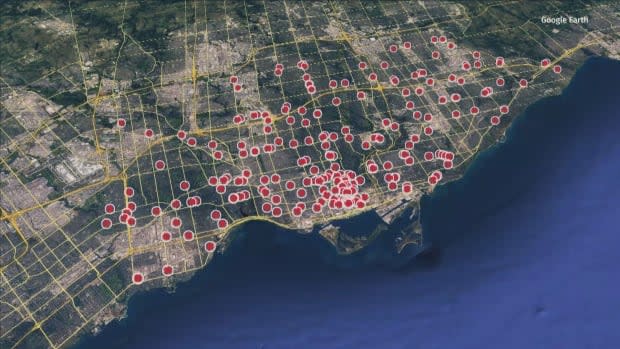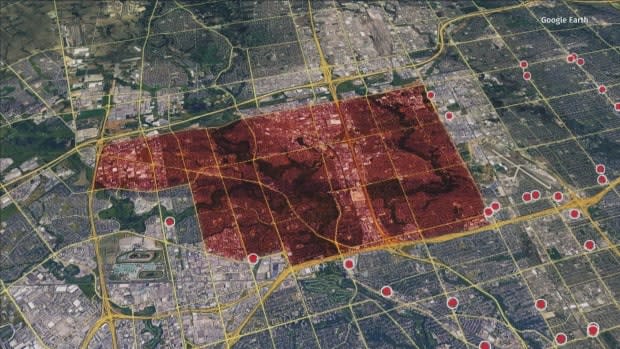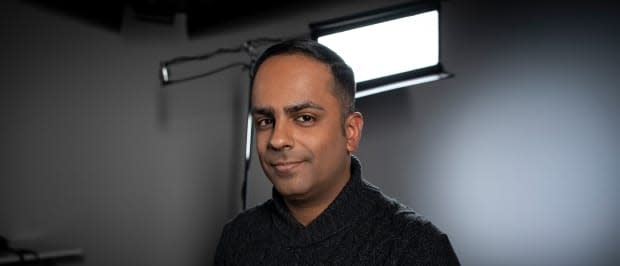Toronto communities hardest-hit by pandemic sound alarm about inequitable distribution of vaccines

As some pharmacies begin offering the AstraZeneca Oxford vaccine to residents aged 60 years and older, communities hardest-hit by the pandemic are sounding the alarm about the inequitable distribution of vaccines in vulnerable areas of Toronto.
On Friday, dozens of people eligible for the vaccine lined up outside various Shoppers Drug Marts in the Yonge—Eglinton neighbourhood as well as in the Annex neighbourhood to receive their shot.
The pharmacy project previously only offered it to those aged 60 to 64, but the government expanded it after new guidelines deemed the shot safe for those 65 and older.
For Stephnie Payne, a Toronto District School Board trustee and long-time Black Creek community member in the Jane and Finch area, there were no lines in her neighbourhood. That's because no pharmacy near her is part of the provincial vaccine pilot project.
"Our lives matter just as much as the affluent lives matter," Payne said, adding that the neglect mirrors the minimal effort government and city officials have put into addressing concerns voiced by the Black community since the start of the pandemic.
"The Black community is being put at a disadvantage because we're not sure who to go to or how to access the vaccine," she said.
CBC News mapped out the pharmacies in the city that are offering vaccinations, and found they are primarily in Toronto's most affluent neighbourhoods.

In vulnerable areas like the northwest end of the city, which is home to many essential workers, low-income racialized people and multi-generational households, it's like a desert for pharmacies offering the vaccine.
Dr. Naheed Dosani, a physician and health-justice advocate in Toronto, said there is "structural inequity" in the way the COVID-19 vaccine is being accessed.
"Vaccines are being distributed on a per capita basis, not necessarily based on need."

Hardest-hit communities still disproportionately impacted
There are currently 327 pharmacies in three public health units — Toronto, Windsor-Essex and Kingston, Frontenac and Addington & Lennox — participating in the pilot program.
Since the start of the pandemic, COVID-19 has disproportionately impacted certain communities such as the northwest end of Toronto, Scarborough and Peel Region. Dosani said that even after much discussion about prioritizing vulnerable people, the government continues to miss the mark for health equity.
"This province took a stand that we were going to support those in need. We were going to prioritize those who are most vulnerable ... There are some areas that are more in need than others, and those areas should be getting more vaccines," he said.
He said it's very hard to ignore the fact that these regions are being left out.
"This is what tends to happen," he said. "Those who are greatest in need have less access to the services that they need."

To address the absence of vaccine options in these areas, Dosani called for the province to better equip community health centres, family doctors, and primary care models in the community with the vaccines, which in turn will also help with vaccine hesitancy.
"[They] know these people, [they] have these relationships and the trust in these communities." He said a "one-size-fits-all" way of addressing vaccine hesitancy won't cut it.
Vhil Castillejos, the manager of community well being at Jane/Finch Community and Family Centre, which has continued to reach out to older adults in the community to connect them to resources, supports and services, said a lot of the resources needed to help combat COVID-19 were not in the community to begin with.
He said there were very few testing sites in the community, for example, when the sites began popping up earlier in the pandemic. He said the vaccine rollout is following this same trend.
As more pharmacies come on board the program, he said he hopes his area will be prioritized.
Pilot project doubling in size, no word on new locations
On Friday, the province announced pharmacies offering the vaccines are soon expected to double in size as they await more vaccine supply from the federal government.
Another 350 pharmacies are expected to be brought on board the pilot in the next two weeks, bringing the total to approximately 700 locations, the Ministry of Health said in a statement.
They added that 1,500 pharmacies offering the vaccine were expected by the end of April.
As of Friday, about 91,000 people have received a first dose of a vaccine at a pharmacy, Premier Doug Ford said.
Depending on vaccine supply, the province said pharmacies could administer up to 40 per cent of all vaccinations by the end of April.
There is no word on where the new pharmacy locations will be, although the province said details are expected in the coming days.
Earlier this month, Mississauga Mayor Bonnie Crombie said she was disappointed that Peel Region was not included in the province's pharmacy pilot project.
Residents of some hard-hit communities hope to finally be included in this second phase of the pilot.
"Don't ignore us, don't neglect us, we're all here and we need the health care that we're paying for," Payne said.

